Strategic Integration for Expansion: A Plan to Enhance Customer Base
VerifiedAdded on 2019/12/03
|13
|4172
|298
Report
AI Summary
The assignment content discusses the creation of summit places to expand the customer base. The target market is business elites who visit the places for their summits and meetings. The organization has launched facilities for this specific group, with arrangements made according to their needs. Pricing policy is kept exorbitant due to targeting elite clients. Financial feasibility requires a big investment, with loans taken from financial institutes and banks. A minimum of $10,000 net profit and maximum of $15,000 on full occupancy are expected.
Contribute Materials
Your contribution can guide someone’s learning journey. Share your
documents today.
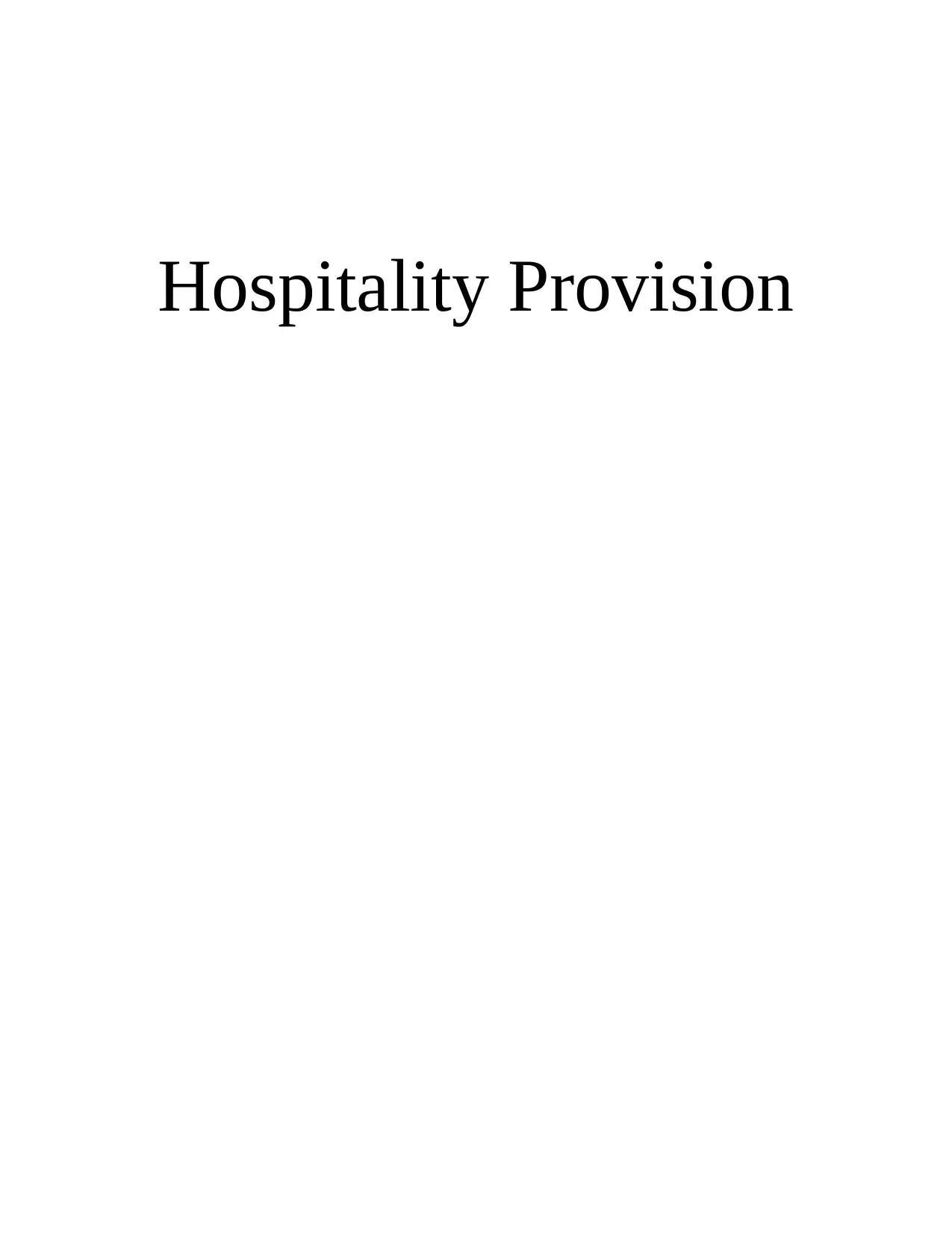
Hospitality Provision
Secure Best Marks with AI Grader
Need help grading? Try our AI Grader for instant feedback on your assignments.
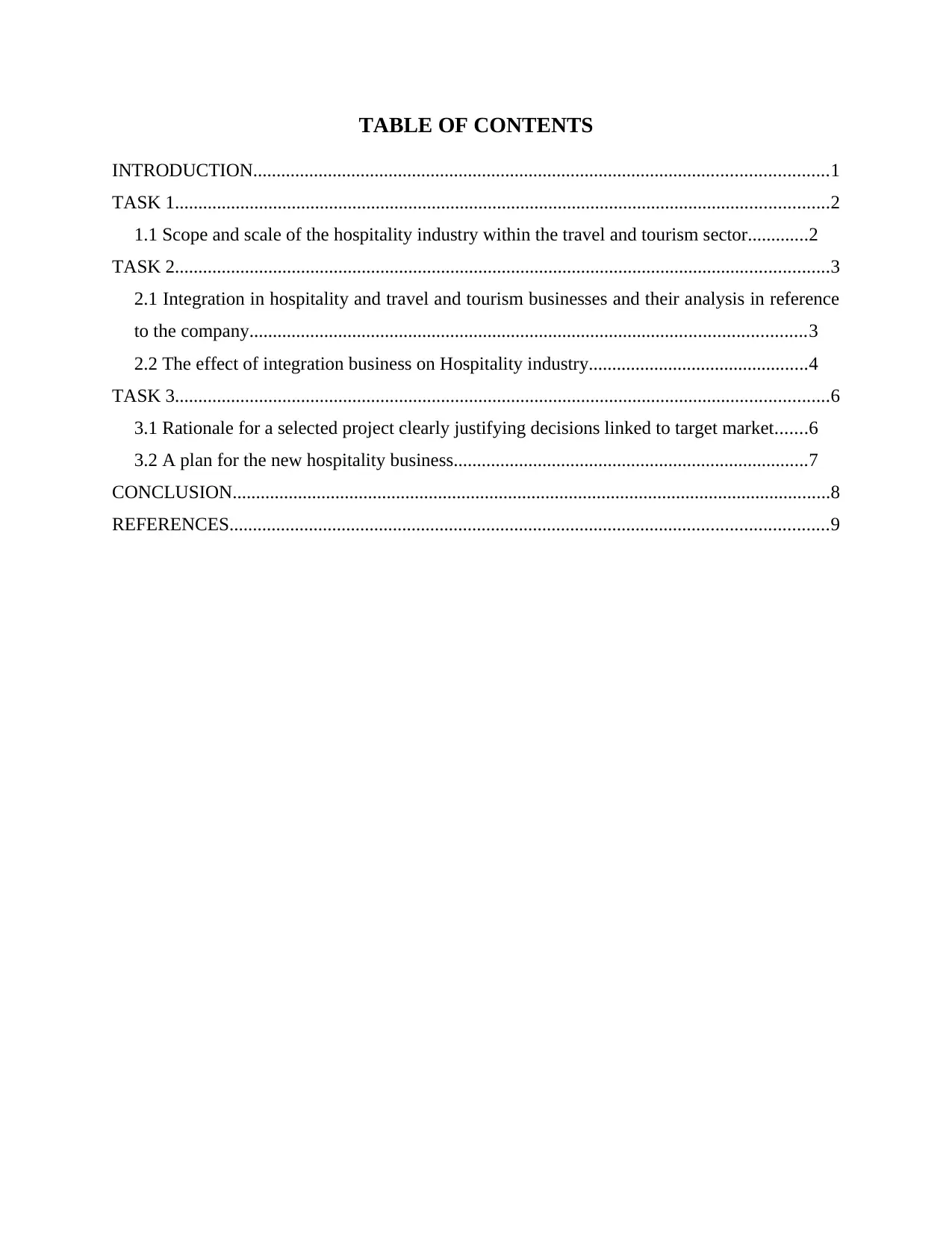
TABLE OF CONTENTS
INTRODUCTION...........................................................................................................................1
TASK 1............................................................................................................................................2
1.1 Scope and scale of the hospitality industry within the travel and tourism sector.............2
TASK 2............................................................................................................................................3
2.1 Integration in hospitality and travel and tourism businesses and their analysis in reference
to the company.......................................................................................................................3
2.2 The effect of integration business on Hospitality industry...............................................4
TASK 3............................................................................................................................................6
3.1 Rationale for a selected project clearly justifying decisions linked to target market.......6
3.2 A plan for the new hospitality business............................................................................7
CONCLUSION................................................................................................................................8
REFERENCES................................................................................................................................9
INTRODUCTION...........................................................................................................................1
TASK 1............................................................................................................................................2
1.1 Scope and scale of the hospitality industry within the travel and tourism sector.............2
TASK 2............................................................................................................................................3
2.1 Integration in hospitality and travel and tourism businesses and their analysis in reference
to the company.......................................................................................................................3
2.2 The effect of integration business on Hospitality industry...............................................4
TASK 3............................................................................................................................................6
3.1 Rationale for a selected project clearly justifying decisions linked to target market.......6
3.2 A plan for the new hospitality business............................................................................7
CONCLUSION................................................................................................................................8
REFERENCES................................................................................................................................9
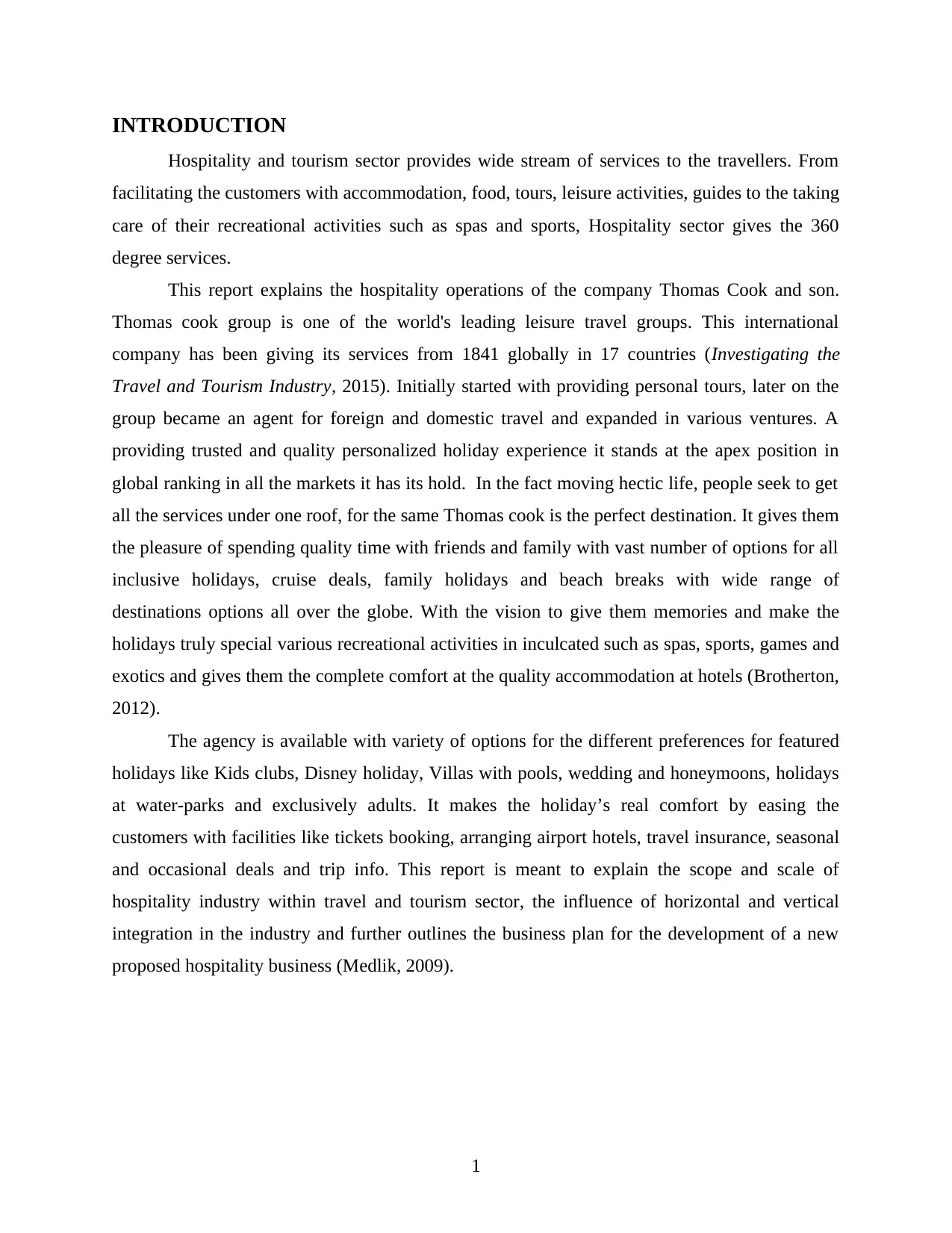
INTRODUCTION
Hospitality and tourism sector provides wide stream of services to the travellers. From
facilitating the customers with accommodation, food, tours, leisure activities, guides to the taking
care of their recreational activities such as spas and sports, Hospitality sector gives the 360
degree services.
This report explains the hospitality operations of the company Thomas Cook and son.
Thomas cook group is one of the world's leading leisure travel groups. This international
company has been giving its services from 1841 globally in 17 countries (Investigating the
Travel and Tourism Industry, 2015). Initially started with providing personal tours, later on the
group became an agent for foreign and domestic travel and expanded in various ventures. A
providing trusted and quality personalized holiday experience it stands at the apex position in
global ranking in all the markets it has its hold. In the fact moving hectic life, people seek to get
all the services under one roof, for the same Thomas cook is the perfect destination. It gives them
the pleasure of spending quality time with friends and family with vast number of options for all
inclusive holidays, cruise deals, family holidays and beach breaks with wide range of
destinations options all over the globe. With the vision to give them memories and make the
holidays truly special various recreational activities in inculcated such as spas, sports, games and
exotics and gives them the complete comfort at the quality accommodation at hotels (Brotherton,
2012).
The agency is available with variety of options for the different preferences for featured
holidays like Kids clubs, Disney holiday, Villas with pools, wedding and honeymoons, holidays
at water-parks and exclusively adults. It makes the holiday’s real comfort by easing the
customers with facilities like tickets booking, arranging airport hotels, travel insurance, seasonal
and occasional deals and trip info. This report is meant to explain the scope and scale of
hospitality industry within travel and tourism sector, the influence of horizontal and vertical
integration in the industry and further outlines the business plan for the development of a new
proposed hospitality business (Medlik, 2009).
1
Hospitality and tourism sector provides wide stream of services to the travellers. From
facilitating the customers with accommodation, food, tours, leisure activities, guides to the taking
care of their recreational activities such as spas and sports, Hospitality sector gives the 360
degree services.
This report explains the hospitality operations of the company Thomas Cook and son.
Thomas cook group is one of the world's leading leisure travel groups. This international
company has been giving its services from 1841 globally in 17 countries (Investigating the
Travel and Tourism Industry, 2015). Initially started with providing personal tours, later on the
group became an agent for foreign and domestic travel and expanded in various ventures. A
providing trusted and quality personalized holiday experience it stands at the apex position in
global ranking in all the markets it has its hold. In the fact moving hectic life, people seek to get
all the services under one roof, for the same Thomas cook is the perfect destination. It gives them
the pleasure of spending quality time with friends and family with vast number of options for all
inclusive holidays, cruise deals, family holidays and beach breaks with wide range of
destinations options all over the globe. With the vision to give them memories and make the
holidays truly special various recreational activities in inculcated such as spas, sports, games and
exotics and gives them the complete comfort at the quality accommodation at hotels (Brotherton,
2012).
The agency is available with variety of options for the different preferences for featured
holidays like Kids clubs, Disney holiday, Villas with pools, wedding and honeymoons, holidays
at water-parks and exclusively adults. It makes the holiday’s real comfort by easing the
customers with facilities like tickets booking, arranging airport hotels, travel insurance, seasonal
and occasional deals and trip info. This report is meant to explain the scope and scale of
hospitality industry within travel and tourism sector, the influence of horizontal and vertical
integration in the industry and further outlines the business plan for the development of a new
proposed hospitality business (Medlik, 2009).
1
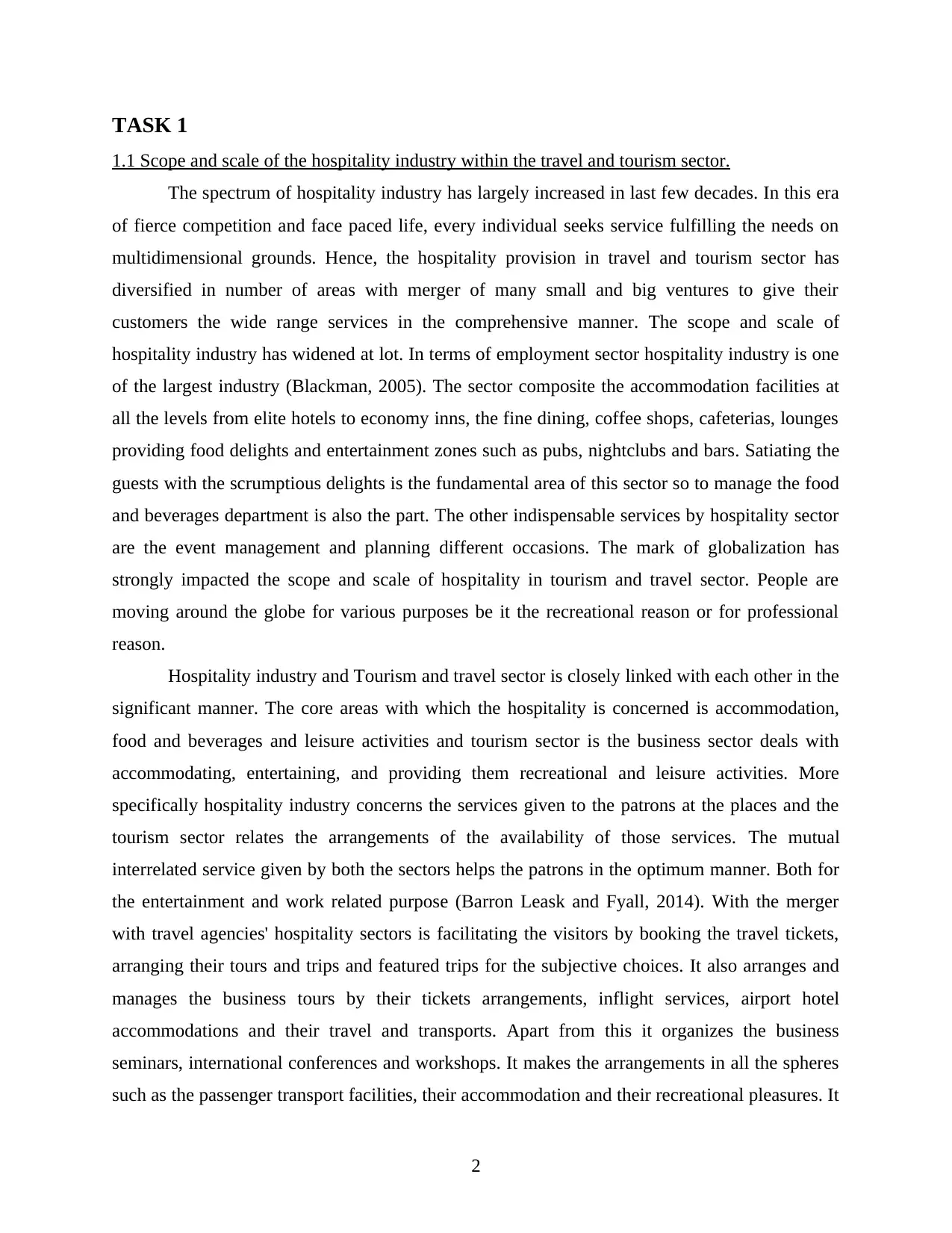
TASK 1
1.1 Scope and scale of the hospitality industry within the travel and tourism sector.
The spectrum of hospitality industry has largely increased in last few decades. In this era
of fierce competition and face paced life, every individual seeks service fulfilling the needs on
multidimensional grounds. Hence, the hospitality provision in travel and tourism sector has
diversified in number of areas with merger of many small and big ventures to give their
customers the wide range services in the comprehensive manner. The scope and scale of
hospitality industry has widened at lot. In terms of employment sector hospitality industry is one
of the largest industry (Blackman, 2005). The sector composite the accommodation facilities at
all the levels from elite hotels to economy inns, the fine dining, coffee shops, cafeterias, lounges
providing food delights and entertainment zones such as pubs, nightclubs and bars. Satiating the
guests with the scrumptious delights is the fundamental area of this sector so to manage the food
and beverages department is also the part. The other indispensable services by hospitality sector
are the event management and planning different occasions. The mark of globalization has
strongly impacted the scope and scale of hospitality in tourism and travel sector. People are
moving around the globe for various purposes be it the recreational reason or for professional
reason.
Hospitality industry and Tourism and travel sector is closely linked with each other in the
significant manner. The core areas with which the hospitality is concerned is accommodation,
food and beverages and leisure activities and tourism sector is the business sector deals with
accommodating, entertaining, and providing them recreational and leisure activities. More
specifically hospitality industry concerns the services given to the patrons at the places and the
tourism sector relates the arrangements of the availability of those services. The mutual
interrelated service given by both the sectors helps the patrons in the optimum manner. Both for
the entertainment and work related purpose (Barron Leask and Fyall, 2014). With the merger
with travel agencies' hospitality sectors is facilitating the visitors by booking the travel tickets,
arranging their tours and trips and featured trips for the subjective choices. It also arranges and
manages the business tours by their tickets arrangements, inflight services, airport hotel
accommodations and their travel and transports. Apart from this it organizes the business
seminars, international conferences and workshops. It makes the arrangements in all the spheres
such as the passenger transport facilities, their accommodation and their recreational pleasures. It
2
1.1 Scope and scale of the hospitality industry within the travel and tourism sector.
The spectrum of hospitality industry has largely increased in last few decades. In this era
of fierce competition and face paced life, every individual seeks service fulfilling the needs on
multidimensional grounds. Hence, the hospitality provision in travel and tourism sector has
diversified in number of areas with merger of many small and big ventures to give their
customers the wide range services in the comprehensive manner. The scope and scale of
hospitality industry has widened at lot. In terms of employment sector hospitality industry is one
of the largest industry (Blackman, 2005). The sector composite the accommodation facilities at
all the levels from elite hotels to economy inns, the fine dining, coffee shops, cafeterias, lounges
providing food delights and entertainment zones such as pubs, nightclubs and bars. Satiating the
guests with the scrumptious delights is the fundamental area of this sector so to manage the food
and beverages department is also the part. The other indispensable services by hospitality sector
are the event management and planning different occasions. The mark of globalization has
strongly impacted the scope and scale of hospitality in tourism and travel sector. People are
moving around the globe for various purposes be it the recreational reason or for professional
reason.
Hospitality industry and Tourism and travel sector is closely linked with each other in the
significant manner. The core areas with which the hospitality is concerned is accommodation,
food and beverages and leisure activities and tourism sector is the business sector deals with
accommodating, entertaining, and providing them recreational and leisure activities. More
specifically hospitality industry concerns the services given to the patrons at the places and the
tourism sector relates the arrangements of the availability of those services. The mutual
interrelated service given by both the sectors helps the patrons in the optimum manner. Both for
the entertainment and work related purpose (Barron Leask and Fyall, 2014). With the merger
with travel agencies' hospitality sectors is facilitating the visitors by booking the travel tickets,
arranging their tours and trips and featured trips for the subjective choices. It also arranges and
manages the business tours by their tickets arrangements, inflight services, airport hotel
accommodations and their travel and transports. Apart from this it organizes the business
seminars, international conferences and workshops. It makes the arrangements in all the spheres
such as the passenger transport facilities, their accommodation and their recreational pleasures. It
2
Secure Best Marks with AI Grader
Need help grading? Try our AI Grader for instant feedback on your assignments.

also arranges the tour and trips for different theme parks with the help of tourism and travel
sectors (Lashley, 2015). Theme parks such as the Disney parks, the tours at water-parks, tour for
kids at kids clubs. The sector is not confined to these areas. It also accommodates the sports-
persons in their trips and tours on national and international level. The organization of various
tournaments and awards also their area of job. The hospitality sector is also giving its services in
entertainment and other media related industry. Tour operators and travel agents organises the
official trips of the business elites from around the globe making their visit comfortable at every
stratum by giving them services with full precision(Baum, 2008). The scope of the industries is
widened to this sector as well.
TASK 2
2.1 Integration in hospitality and travel and tourism businesses and their analysis in reference to
the company.
To make the business more profitable and lucrative on various grounds it merges with
other industries on many levels. It can be done on two ways i.e. on vertical and horizontal basis.
The vertical integration means the merger with companies of the similar sectors with the related
industry while the horizontal merger relates to the merger with the companies providing the
similar services on global ground.
The Thomas Cook group merges with the industries such as tourism industry, travel
agencies and with the companies that providing the recreational facilities such as the spas and
many more (Ingram and Grieve, 2013).
It has the horizontal merger with the company’s such the mass market and Cox and kings.
They are the tour travel agencies. They offer the accommodation facilities, transport facilities
and the other activities to make the holidays more recreational and luxurious. Cox and kings are
the specialists in their fields. The give the best experience to the adventure lovers. They have the
special team of expertise to take care of quality tours, private journeys and tailor made holidays.
With this they provide the patrons with memories and luxuries and the exceptional quality time.
Thomas cook merging with the other industries within the same sector increases the profitability
with the multiplier effect (Crawford, 2013). The industries with which the Thomas cook merges
are:
3
sectors (Lashley, 2015). Theme parks such as the Disney parks, the tours at water-parks, tour for
kids at kids clubs. The sector is not confined to these areas. It also accommodates the sports-
persons in their trips and tours on national and international level. The organization of various
tournaments and awards also their area of job. The hospitality sector is also giving its services in
entertainment and other media related industry. Tour operators and travel agents organises the
official trips of the business elites from around the globe making their visit comfortable at every
stratum by giving them services with full precision(Baum, 2008). The scope of the industries is
widened to this sector as well.
TASK 2
2.1 Integration in hospitality and travel and tourism businesses and their analysis in reference to
the company.
To make the business more profitable and lucrative on various grounds it merges with
other industries on many levels. It can be done on two ways i.e. on vertical and horizontal basis.
The vertical integration means the merger with companies of the similar sectors with the related
industry while the horizontal merger relates to the merger with the companies providing the
similar services on global ground.
The Thomas Cook group merges with the industries such as tourism industry, travel
agencies and with the companies that providing the recreational facilities such as the spas and
many more (Ingram and Grieve, 2013).
It has the horizontal merger with the company’s such the mass market and Cox and kings.
They are the tour travel agencies. They offer the accommodation facilities, transport facilities
and the other activities to make the holidays more recreational and luxurious. Cox and kings are
the specialists in their fields. The give the best experience to the adventure lovers. They have the
special team of expertise to take care of quality tours, private journeys and tailor made holidays.
With this they provide the patrons with memories and luxuries and the exceptional quality time.
Thomas cook merging with the other industries within the same sector increases the profitability
with the multiplier effect (Crawford, 2013). The industries with which the Thomas cook merges
are:
3

The tour operators and travel agents: with the collaboration with the tour agents and
travel agents the Thomas Cook makes arrangements for the whole trip in the comprehensive way
which minimizes the cost and increases the profit margin.
Hotel industry: The major share of the revenue of hospitality depends on the rent earnings. The
group merges with the hotels and accommodation sources, keeping at prime position.
Apparels and clothing: The group is merging with the clothing and apparel industry. Tie-ups
with the Apparels and clothing industry affect the industry in the significant way. The tourist
main concern is for the leisure and shopping that to account basically for clothing (Symons,
2013).
The links with the refreshment and entertainment zones such as the bars and casinos: It escalates
the earnings of the hospitality industry in the very extraordinary way. The most attractive zone
for the guest and tourists largely affect them. It is the market with major share in the
entertainment industry.
Travel finances: With the tie-ups with the travel related finance agencies it plays a very vital role
in facilitating the visitors. For the cross border tourists it arranges the foreign currency and
prepaid foreign currency cards (Sanjeev, Gupta and Bandyopadhyay, 2012).
Insurances: The group is also is in links with many financial institutions, organisation and banks
who provide the insurances. Assuring the safety of their guests Thomas cook provides the travel
insurances to them.
Vouchers and deals: To make the holidays specials for the tourists and travellers they provide
them many vouchers and special deals.
Aviation: Seeing the frequency of domestic and international movement of guests through flights
they have tied with some airlines. Such as the German airline condor in Germany occupy the
significant figure of passengers and air capacity requirements (Harrington and et.al, 2014).
Ancillaries: The group also make arrangements for the ancillaries required for the travel and
journey. Through many retail outlets and websites it provides the availability of those
requirements of baggage and other stuffs.
2.2 The effect of integration business on Hospitality industry
The integration of hospitality business vertically and horizontally with many small and
big businesses has created the value in a very substantive manner. Bringing so many firms and
4
travel agents the Thomas Cook makes arrangements for the whole trip in the comprehensive way
which minimizes the cost and increases the profit margin.
Hotel industry: The major share of the revenue of hospitality depends on the rent earnings. The
group merges with the hotels and accommodation sources, keeping at prime position.
Apparels and clothing: The group is merging with the clothing and apparel industry. Tie-ups
with the Apparels and clothing industry affect the industry in the significant way. The tourist
main concern is for the leisure and shopping that to account basically for clothing (Symons,
2013).
The links with the refreshment and entertainment zones such as the bars and casinos: It escalates
the earnings of the hospitality industry in the very extraordinary way. The most attractive zone
for the guest and tourists largely affect them. It is the market with major share in the
entertainment industry.
Travel finances: With the tie-ups with the travel related finance agencies it plays a very vital role
in facilitating the visitors. For the cross border tourists it arranges the foreign currency and
prepaid foreign currency cards (Sanjeev, Gupta and Bandyopadhyay, 2012).
Insurances: The group is also is in links with many financial institutions, organisation and banks
who provide the insurances. Assuring the safety of their guests Thomas cook provides the travel
insurances to them.
Vouchers and deals: To make the holidays specials for the tourists and travellers they provide
them many vouchers and special deals.
Aviation: Seeing the frequency of domestic and international movement of guests through flights
they have tied with some airlines. Such as the German airline condor in Germany occupy the
significant figure of passengers and air capacity requirements (Harrington and et.al, 2014).
Ancillaries: The group also make arrangements for the ancillaries required for the travel and
journey. Through many retail outlets and websites it provides the availability of those
requirements of baggage and other stuffs.
2.2 The effect of integration business on Hospitality industry
The integration of hospitality business vertically and horizontally with many small and
big businesses has created the value in a very substantive manner. Bringing so many firms and
4
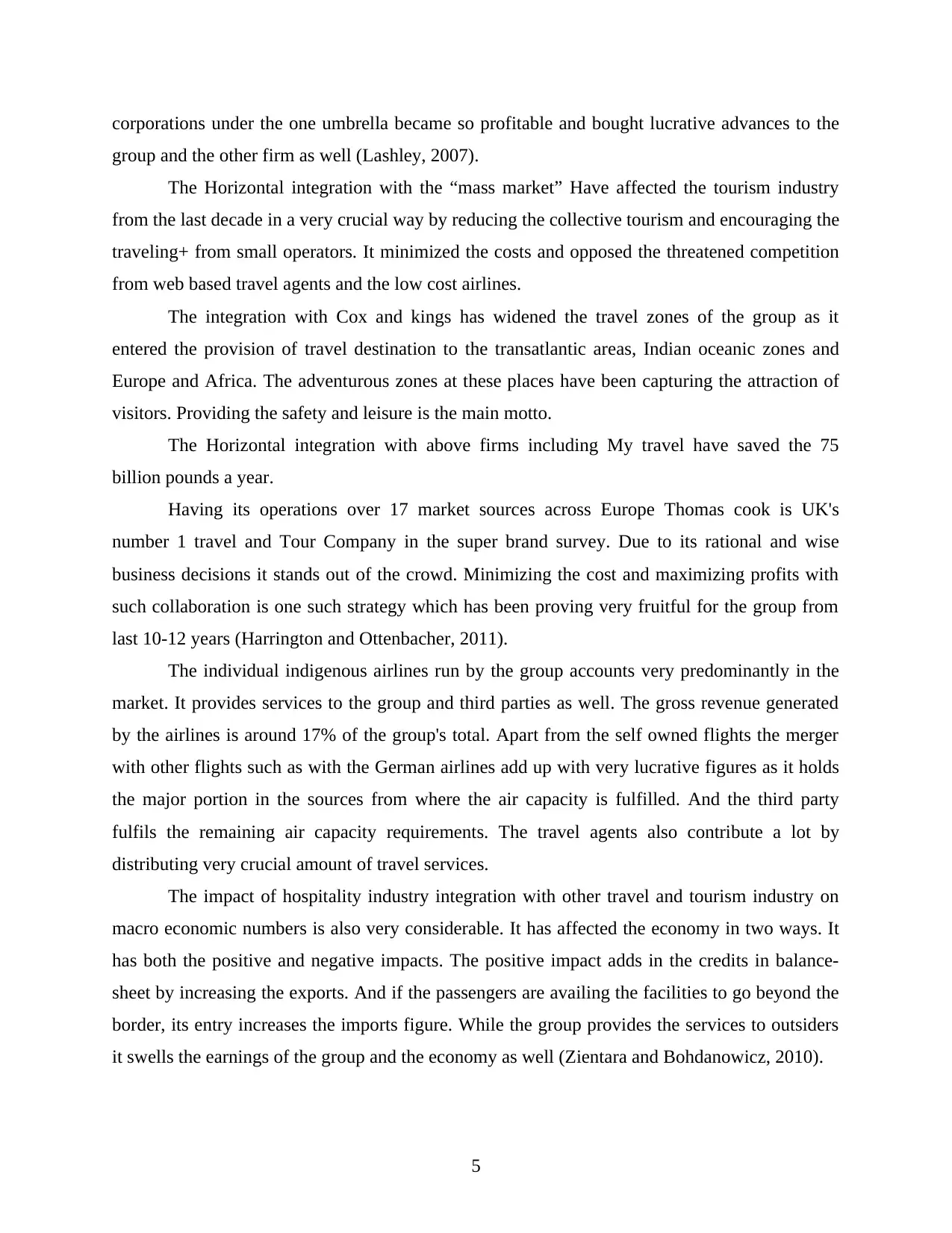
corporations under the one umbrella became so profitable and bought lucrative advances to the
group and the other firm as well (Lashley, 2007).
The Horizontal integration with the “mass market” Have affected the tourism industry
from the last decade in a very crucial way by reducing the collective tourism and encouraging the
traveling+ from small operators. It minimized the costs and opposed the threatened competition
from web based travel agents and the low cost airlines.
The integration with Cox and kings has widened the travel zones of the group as it
entered the provision of travel destination to the transatlantic areas, Indian oceanic zones and
Europe and Africa. The adventurous zones at these places have been capturing the attraction of
visitors. Providing the safety and leisure is the main motto.
The Horizontal integration with above firms including My travel have saved the 75
billion pounds a year.
Having its operations over 17 market sources across Europe Thomas cook is UK's
number 1 travel and Tour Company in the super brand survey. Due to its rational and wise
business decisions it stands out of the crowd. Minimizing the cost and maximizing profits with
such collaboration is one such strategy which has been proving very fruitful for the group from
last 10-12 years (Harrington and Ottenbacher, 2011).
The individual indigenous airlines run by the group accounts very predominantly in the
market. It provides services to the group and third parties as well. The gross revenue generated
by the airlines is around 17% of the group's total. Apart from the self owned flights the merger
with other flights such as with the German airlines add up with very lucrative figures as it holds
the major portion in the sources from where the air capacity is fulfilled. And the third party
fulfils the remaining air capacity requirements. The travel agents also contribute a lot by
distributing very crucial amount of travel services.
The impact of hospitality industry integration with other travel and tourism industry on
macro economic numbers is also very considerable. It has affected the economy in two ways. It
has both the positive and negative impacts. The positive impact adds in the credits in balance-
sheet by increasing the exports. And if the passengers are availing the facilities to go beyond the
border, its entry increases the imports figure. While the group provides the services to outsiders
it swells the earnings of the group and the economy as well (Zientara and Bohdanowicz, 2010).
5
group and the other firm as well (Lashley, 2007).
The Horizontal integration with the “mass market” Have affected the tourism industry
from the last decade in a very crucial way by reducing the collective tourism and encouraging the
traveling+ from small operators. It minimized the costs and opposed the threatened competition
from web based travel agents and the low cost airlines.
The integration with Cox and kings has widened the travel zones of the group as it
entered the provision of travel destination to the transatlantic areas, Indian oceanic zones and
Europe and Africa. The adventurous zones at these places have been capturing the attraction of
visitors. Providing the safety and leisure is the main motto.
The Horizontal integration with above firms including My travel have saved the 75
billion pounds a year.
Having its operations over 17 market sources across Europe Thomas cook is UK's
number 1 travel and Tour Company in the super brand survey. Due to its rational and wise
business decisions it stands out of the crowd. Minimizing the cost and maximizing profits with
such collaboration is one such strategy which has been proving very fruitful for the group from
last 10-12 years (Harrington and Ottenbacher, 2011).
The individual indigenous airlines run by the group accounts very predominantly in the
market. It provides services to the group and third parties as well. The gross revenue generated
by the airlines is around 17% of the group's total. Apart from the self owned flights the merger
with other flights such as with the German airlines add up with very lucrative figures as it holds
the major portion in the sources from where the air capacity is fulfilled. And the third party
fulfils the remaining air capacity requirements. The travel agents also contribute a lot by
distributing very crucial amount of travel services.
The impact of hospitality industry integration with other travel and tourism industry on
macro economic numbers is also very considerable. It has affected the economy in two ways. It
has both the positive and negative impacts. The positive impact adds in the credits in balance-
sheet by increasing the exports. And if the passengers are availing the facilities to go beyond the
border, its entry increases the imports figure. While the group provides the services to outsiders
it swells the earnings of the group and the economy as well (Zientara and Bohdanowicz, 2010).
5
Paraphrase This Document
Need a fresh take? Get an instant paraphrase of this document with our AI Paraphraser
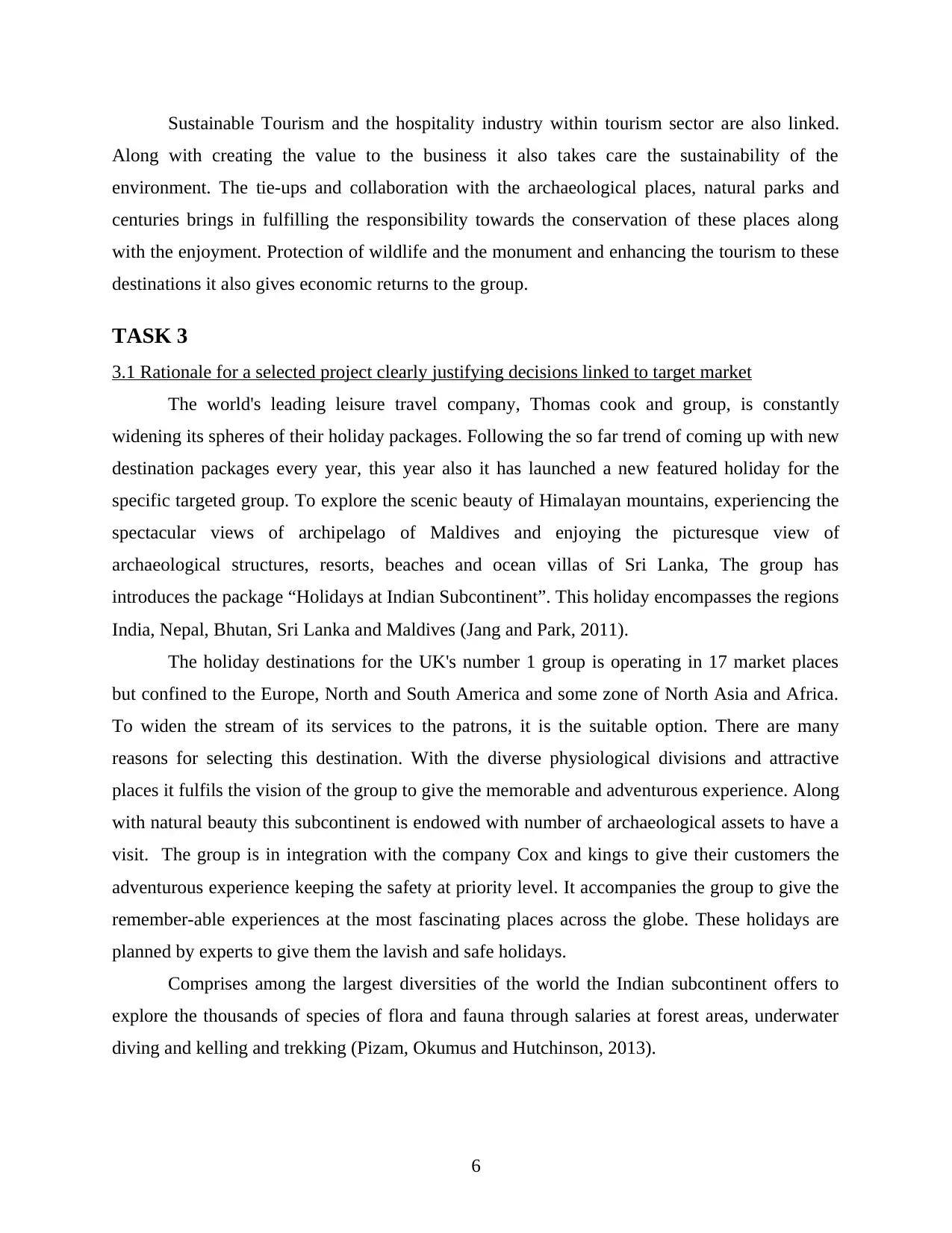
Sustainable Tourism and the hospitality industry within tourism sector are also linked.
Along with creating the value to the business it also takes care the sustainability of the
environment. The tie-ups and collaboration with the archaeological places, natural parks and
centuries brings in fulfilling the responsibility towards the conservation of these places along
with the enjoyment. Protection of wildlife and the monument and enhancing the tourism to these
destinations it also gives economic returns to the group.
TASK 3
3.1 Rationale for a selected project clearly justifying decisions linked to target market
The world's leading leisure travel company, Thomas cook and group, is constantly
widening its spheres of their holiday packages. Following the so far trend of coming up with new
destination packages every year, this year also it has launched a new featured holiday for the
specific targeted group. To explore the scenic beauty of Himalayan mountains, experiencing the
spectacular views of archipelago of Maldives and enjoying the picturesque view of
archaeological structures, resorts, beaches and ocean villas of Sri Lanka, The group has
introduces the package “Holidays at Indian Subcontinent”. This holiday encompasses the regions
India, Nepal, Bhutan, Sri Lanka and Maldives (Jang and Park, 2011).
The holiday destinations for the UK's number 1 group is operating in 17 market places
but confined to the Europe, North and South America and some zone of North Asia and Africa.
To widen the stream of its services to the patrons, it is the suitable option. There are many
reasons for selecting this destination. With the diverse physiological divisions and attractive
places it fulfils the vision of the group to give the memorable and adventurous experience. Along
with natural beauty this subcontinent is endowed with number of archaeological assets to have a
visit. The group is in integration with the company Cox and kings to give their customers the
adventurous experience keeping the safety at priority level. It accompanies the group to give the
remember-able experiences at the most fascinating places across the globe. These holidays are
planned by experts to give them the lavish and safe holidays.
Comprises among the largest diversities of the world the Indian subcontinent offers to
explore the thousands of species of flora and fauna through salaries at forest areas, underwater
diving and kelling and trekking (Pizam, Okumus and Hutchinson, 2013).
6
Along with creating the value to the business it also takes care the sustainability of the
environment. The tie-ups and collaboration with the archaeological places, natural parks and
centuries brings in fulfilling the responsibility towards the conservation of these places along
with the enjoyment. Protection of wildlife and the monument and enhancing the tourism to these
destinations it also gives economic returns to the group.
TASK 3
3.1 Rationale for a selected project clearly justifying decisions linked to target market
The world's leading leisure travel company, Thomas cook and group, is constantly
widening its spheres of their holiday packages. Following the so far trend of coming up with new
destination packages every year, this year also it has launched a new featured holiday for the
specific targeted group. To explore the scenic beauty of Himalayan mountains, experiencing the
spectacular views of archipelago of Maldives and enjoying the picturesque view of
archaeological structures, resorts, beaches and ocean villas of Sri Lanka, The group has
introduces the package “Holidays at Indian Subcontinent”. This holiday encompasses the regions
India, Nepal, Bhutan, Sri Lanka and Maldives (Jang and Park, 2011).
The holiday destinations for the UK's number 1 group is operating in 17 market places
but confined to the Europe, North and South America and some zone of North Asia and Africa.
To widen the stream of its services to the patrons, it is the suitable option. There are many
reasons for selecting this destination. With the diverse physiological divisions and attractive
places it fulfils the vision of the group to give the memorable and adventurous experience. Along
with natural beauty this subcontinent is endowed with number of archaeological assets to have a
visit. The group is in integration with the company Cox and kings to give their customers the
adventurous experience keeping the safety at priority level. It accompanies the group to give the
remember-able experiences at the most fascinating places across the globe. These holidays are
planned by experts to give them the lavish and safe holidays.
Comprises among the largest diversities of the world the Indian subcontinent offers to
explore the thousands of species of flora and fauna through salaries at forest areas, underwater
diving and kelling and trekking (Pizam, Okumus and Hutchinson, 2013).
6
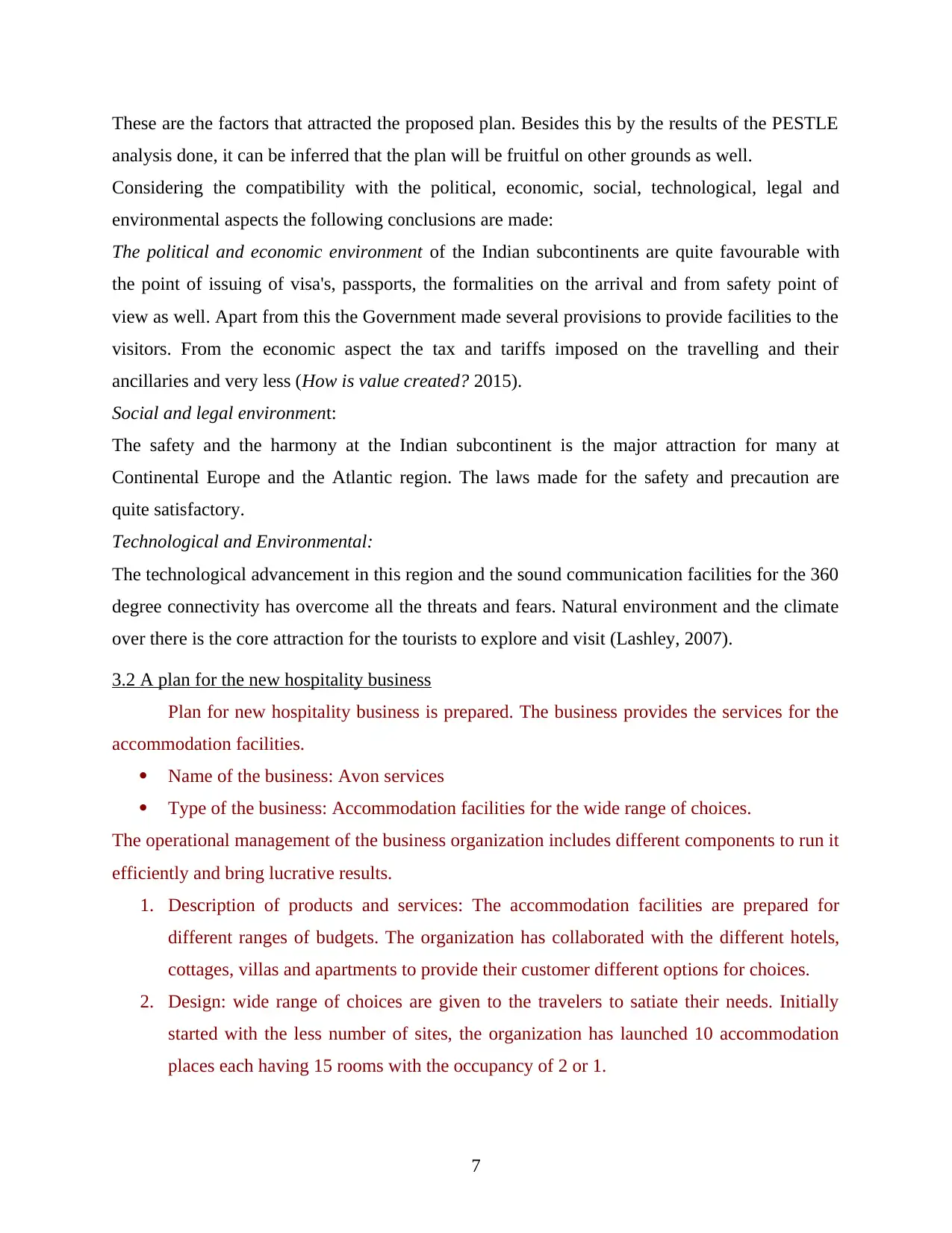
These are the factors that attracted the proposed plan. Besides this by the results of the PESTLE
analysis done, it can be inferred that the plan will be fruitful on other grounds as well.
Considering the compatibility with the political, economic, social, technological, legal and
environmental aspects the following conclusions are made:
The political and economic environment of the Indian subcontinents are quite favourable with
the point of issuing of visa's, passports, the formalities on the arrival and from safety point of
view as well. Apart from this the Government made several provisions to provide facilities to the
visitors. From the economic aspect the tax and tariffs imposed on the travelling and their
ancillaries and very less (How is value created? 2015).
Social and legal environment:
The safety and the harmony at the Indian subcontinent is the major attraction for many at
Continental Europe and the Atlantic region. The laws made for the safety and precaution are
quite satisfactory.
Technological and Environmental:
The technological advancement in this region and the sound communication facilities for the 360
degree connectivity has overcome all the threats and fears. Natural environment and the climate
over there is the core attraction for the tourists to explore and visit (Lashley, 2007).
3.2 A plan for the new hospitality business
Plan for new hospitality business is prepared. The business provides the services for the
accommodation facilities.
Name of the business: Avon services
Type of the business: Accommodation facilities for the wide range of choices.
The operational management of the business organization includes different components to run it
efficiently and bring lucrative results.
1. Description of products and services: The accommodation facilities are prepared for
different ranges of budgets. The organization has collaborated with the different hotels,
cottages, villas and apartments to provide their customer different options for choices.
2. Design: wide range of choices are given to the travelers to satiate their needs. Initially
started with the less number of sites, the organization has launched 10 accommodation
places each having 15 rooms with the occupancy of 2 or 1.
7
analysis done, it can be inferred that the plan will be fruitful on other grounds as well.
Considering the compatibility with the political, economic, social, technological, legal and
environmental aspects the following conclusions are made:
The political and economic environment of the Indian subcontinents are quite favourable with
the point of issuing of visa's, passports, the formalities on the arrival and from safety point of
view as well. Apart from this the Government made several provisions to provide facilities to the
visitors. From the economic aspect the tax and tariffs imposed on the travelling and their
ancillaries and very less (How is value created? 2015).
Social and legal environment:
The safety and the harmony at the Indian subcontinent is the major attraction for many at
Continental Europe and the Atlantic region. The laws made for the safety and precaution are
quite satisfactory.
Technological and Environmental:
The technological advancement in this region and the sound communication facilities for the 360
degree connectivity has overcome all the threats and fears. Natural environment and the climate
over there is the core attraction for the tourists to explore and visit (Lashley, 2007).
3.2 A plan for the new hospitality business
Plan for new hospitality business is prepared. The business provides the services for the
accommodation facilities.
Name of the business: Avon services
Type of the business: Accommodation facilities for the wide range of choices.
The operational management of the business organization includes different components to run it
efficiently and bring lucrative results.
1. Description of products and services: The accommodation facilities are prepared for
different ranges of budgets. The organization has collaborated with the different hotels,
cottages, villas and apartments to provide their customer different options for choices.
2. Design: wide range of choices are given to the travelers to satiate their needs. Initially
started with the less number of sites, the organization has launched 10 accommodation
places each having 15 rooms with the occupancy of 2 or 1.
7
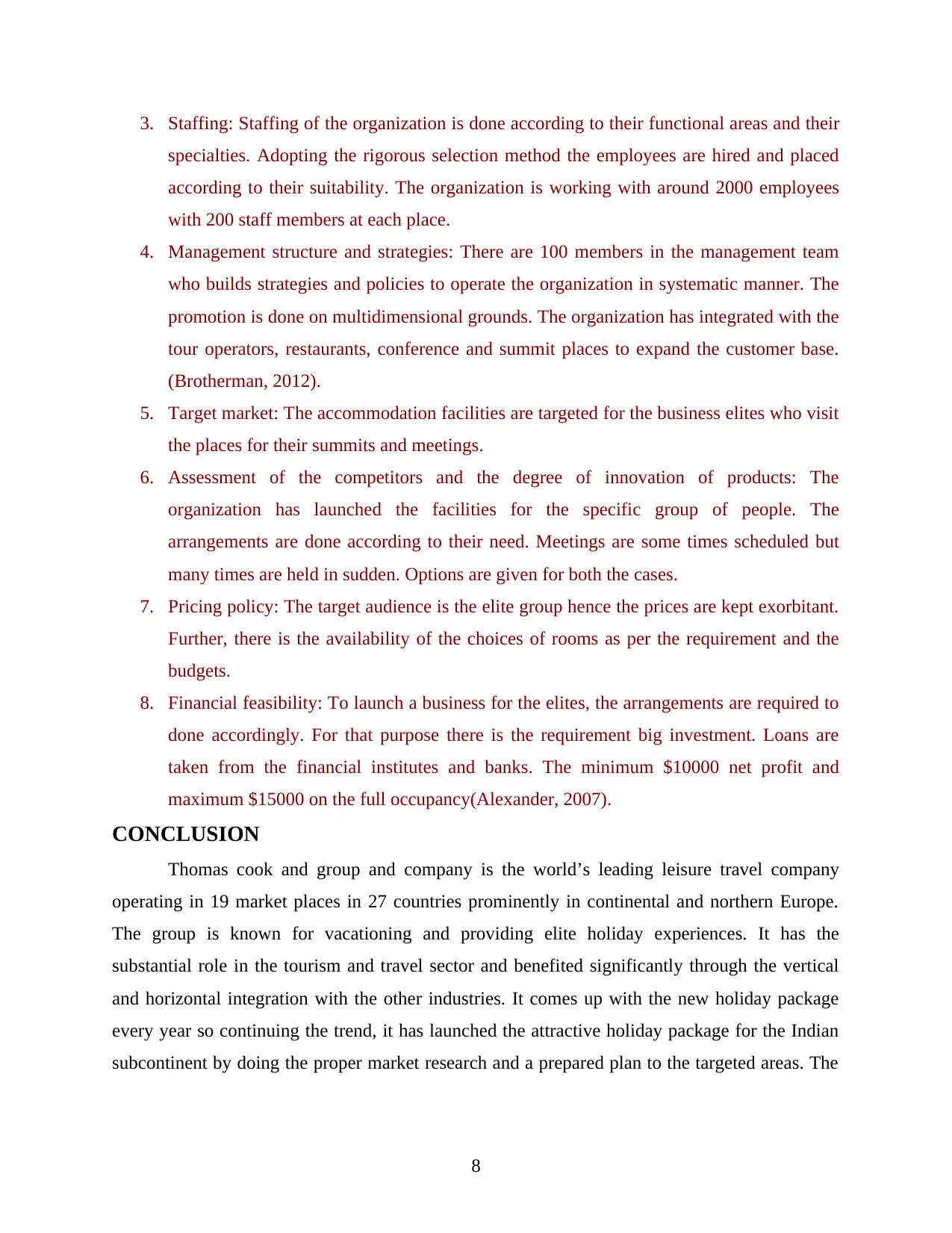
3. Staffing: Staffing of the organization is done according to their functional areas and their
specialties. Adopting the rigorous selection method the employees are hired and placed
according to their suitability. The organization is working with around 2000 employees
with 200 staff members at each place.
4. Management structure and strategies: There are 100 members in the management team
who builds strategies and policies to operate the organization in systematic manner. The
promotion is done on multidimensional grounds. The organization has integrated with the
tour operators, restaurants, conference and summit places to expand the customer base.
(Brotherman, 2012).
5. Target market: The accommodation facilities are targeted for the business elites who visit
the places for their summits and meetings.
6. Assessment of the competitors and the degree of innovation of products: The
organization has launched the facilities for the specific group of people. The
arrangements are done according to their need. Meetings are some times scheduled but
many times are held in sudden. Options are given for both the cases.
7. Pricing policy: The target audience is the elite group hence the prices are kept exorbitant.
Further, there is the availability of the choices of rooms as per the requirement and the
budgets.
8. Financial feasibility: To launch a business for the elites, the arrangements are required to
done accordingly. For that purpose there is the requirement big investment. Loans are
taken from the financial institutes and banks. The minimum $10000 net profit and
maximum $15000 on the full occupancy(Alexander, 2007).
CONCLUSION
Thomas cook and group and company is the world’s leading leisure travel company
operating in 19 market places in 27 countries prominently in continental and northern Europe.
The group is known for vacationing and providing elite holiday experiences. It has the
substantial role in the tourism and travel sector and benefited significantly through the vertical
and horizontal integration with the other industries. It comes up with the new holiday package
every year so continuing the trend, it has launched the attractive holiday package for the Indian
subcontinent by doing the proper market research and a prepared plan to the targeted areas. The
8
specialties. Adopting the rigorous selection method the employees are hired and placed
according to their suitability. The organization is working with around 2000 employees
with 200 staff members at each place.
4. Management structure and strategies: There are 100 members in the management team
who builds strategies and policies to operate the organization in systematic manner. The
promotion is done on multidimensional grounds. The organization has integrated with the
tour operators, restaurants, conference and summit places to expand the customer base.
(Brotherman, 2012).
5. Target market: The accommodation facilities are targeted for the business elites who visit
the places for their summits and meetings.
6. Assessment of the competitors and the degree of innovation of products: The
organization has launched the facilities for the specific group of people. The
arrangements are done according to their need. Meetings are some times scheduled but
many times are held in sudden. Options are given for both the cases.
7. Pricing policy: The target audience is the elite group hence the prices are kept exorbitant.
Further, there is the availability of the choices of rooms as per the requirement and the
budgets.
8. Financial feasibility: To launch a business for the elites, the arrangements are required to
done accordingly. For that purpose there is the requirement big investment. Loans are
taken from the financial institutes and banks. The minimum $10000 net profit and
maximum $15000 on the full occupancy(Alexander, 2007).
CONCLUSION
Thomas cook and group and company is the world’s leading leisure travel company
operating in 19 market places in 27 countries prominently in continental and northern Europe.
The group is known for vacationing and providing elite holiday experiences. It has the
substantial role in the tourism and travel sector and benefited significantly through the vertical
and horizontal integration with the other industries. It comes up with the new holiday package
every year so continuing the trend, it has launched the attractive holiday package for the Indian
subcontinent by doing the proper market research and a prepared plan to the targeted areas. The
8
Secure Best Marks with AI Grader
Need help grading? Try our AI Grader for instant feedback on your assignments.
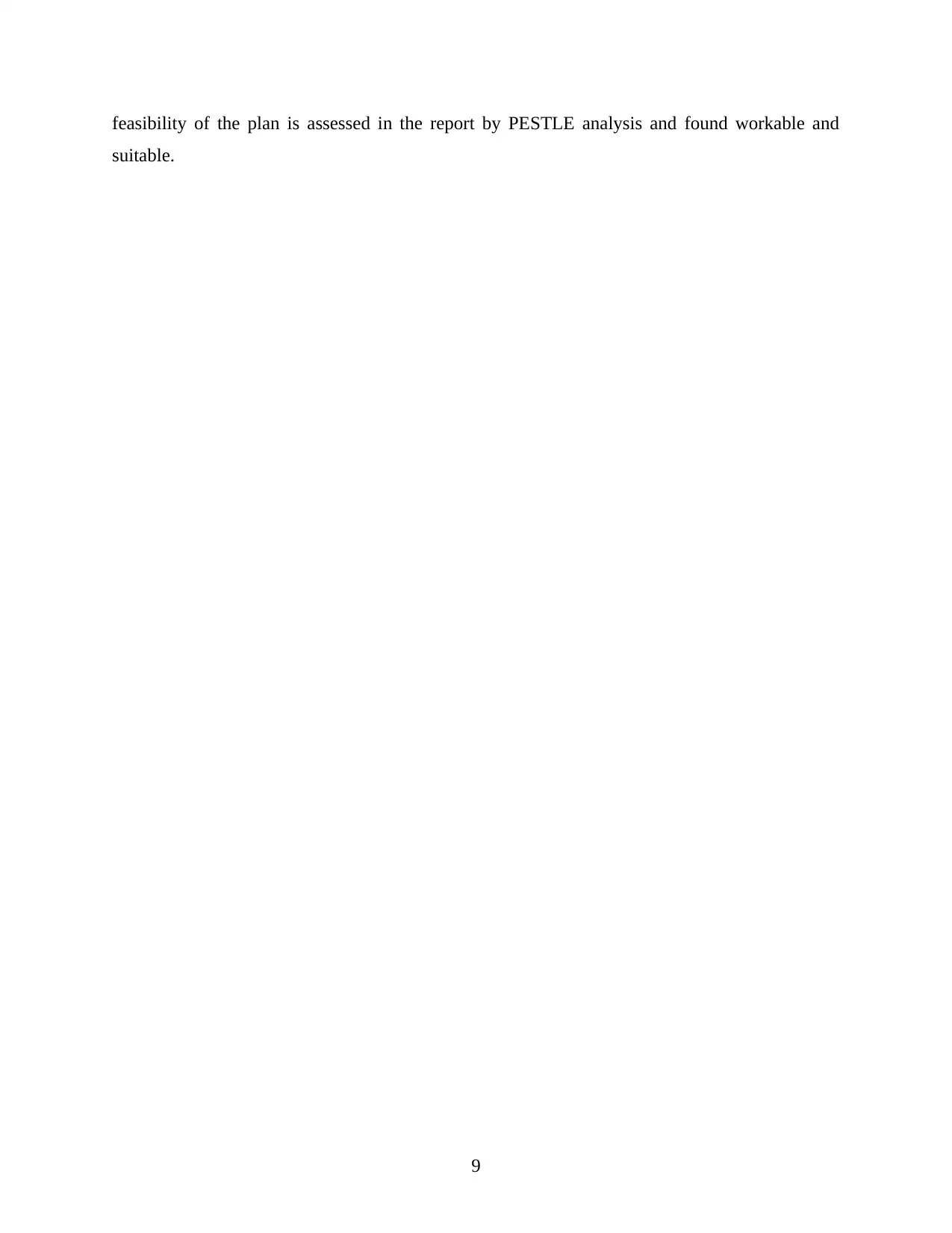
feasibility of the plan is assessed in the report by PESTLE analysis and found workable and
suitable.
9
suitable.
9

REFERENCES
Books
Blackman, H., 2005. Travel & Tourism: AS Level for OCR : GCE AS Level Double Award
Brotherman, B., 2012. Introduction to the UK Hospitality Industry: A Comparative Approach.
Routledge.
Brotherton, B., 2012. International Hospitality Industry. Routledge.
GCE AS Level Series. Heinemann.
Medlik, S., 2009. Tourism and Hospitality in the 21st Century. Routledge.
Morrison, A. M., 2009. Hospitality and Travel Marketing Travel and Tourism Series. 4th Ed.
Delmar Cengage Learning.
Journals
Alexander, M., 2007. Reflecting on changes in operational training in UK hospitality
management degree programmes. International Journal of Contemporary Hospitality
Management. 19(3). pp.211 – 220.
Barron, P., Leask, A. and Fyall, A., 2014. Engaging the multi-generational workforce in tourism
and hospitality. Tourism Review. 69(4). pp.245 – 263.
Baum, T., 2008. Implications of hospitality and tourism labour markets for talent management
strategies. International Journal of Contemporary Hospitality Management. 20(7).
pp.720 – 729.
Crawford, A., 2013. Hospitality operators' understanding of service: a qualitative approach.
International Journal of Contemporary Hospitality Management. 25(1). pp.65 – 81.
Harrington, J. R. and et.al., 2014. Strategic management research in hospitality and tourism: past,
present and future. International Journal of Contemporary Hospitality Management.
26(5). pp.778 – 808.
Harrington, J. R. and Ottenbacher, C. M., 2011. Strategic management: An analysis of its
representation and focus in recent hospitality research. International Journal of
Contemporary Hospitality Management. 23(4). pp.439 – 462.
Ingram, H. and Grieve, D., 2013 Exploring the nature and effects of perception and image in
hospitality and tourism. Worldwide Hospitality and Tourism Themes. 5(1). pp.7 – 13.
Jang, S. and Park, K., 2011. Hospitality finance research during recent two decades: Subjects,
methodologies, and citations. International Journal of Contemporary Hospitality
Management. 23(4). pp.479 – 497.
10
Books
Blackman, H., 2005. Travel & Tourism: AS Level for OCR : GCE AS Level Double Award
Brotherman, B., 2012. Introduction to the UK Hospitality Industry: A Comparative Approach.
Routledge.
Brotherton, B., 2012. International Hospitality Industry. Routledge.
GCE AS Level Series. Heinemann.
Medlik, S., 2009. Tourism and Hospitality in the 21st Century. Routledge.
Morrison, A. M., 2009. Hospitality and Travel Marketing Travel and Tourism Series. 4th Ed.
Delmar Cengage Learning.
Journals
Alexander, M., 2007. Reflecting on changes in operational training in UK hospitality
management degree programmes. International Journal of Contemporary Hospitality
Management. 19(3). pp.211 – 220.
Barron, P., Leask, A. and Fyall, A., 2014. Engaging the multi-generational workforce in tourism
and hospitality. Tourism Review. 69(4). pp.245 – 263.
Baum, T., 2008. Implications of hospitality and tourism labour markets for talent management
strategies. International Journal of Contemporary Hospitality Management. 20(7).
pp.720 – 729.
Crawford, A., 2013. Hospitality operators' understanding of service: a qualitative approach.
International Journal of Contemporary Hospitality Management. 25(1). pp.65 – 81.
Harrington, J. R. and et.al., 2014. Strategic management research in hospitality and tourism: past,
present and future. International Journal of Contemporary Hospitality Management.
26(5). pp.778 – 808.
Harrington, J. R. and Ottenbacher, C. M., 2011. Strategic management: An analysis of its
representation and focus in recent hospitality research. International Journal of
Contemporary Hospitality Management. 23(4). pp.439 – 462.
Ingram, H. and Grieve, D., 2013 Exploring the nature and effects of perception and image in
hospitality and tourism. Worldwide Hospitality and Tourism Themes. 5(1). pp.7 – 13.
Jang, S. and Park, K., 2011. Hospitality finance research during recent two decades: Subjects,
methodologies, and citations. International Journal of Contemporary Hospitality
Management. 23(4). pp.479 – 497.
10
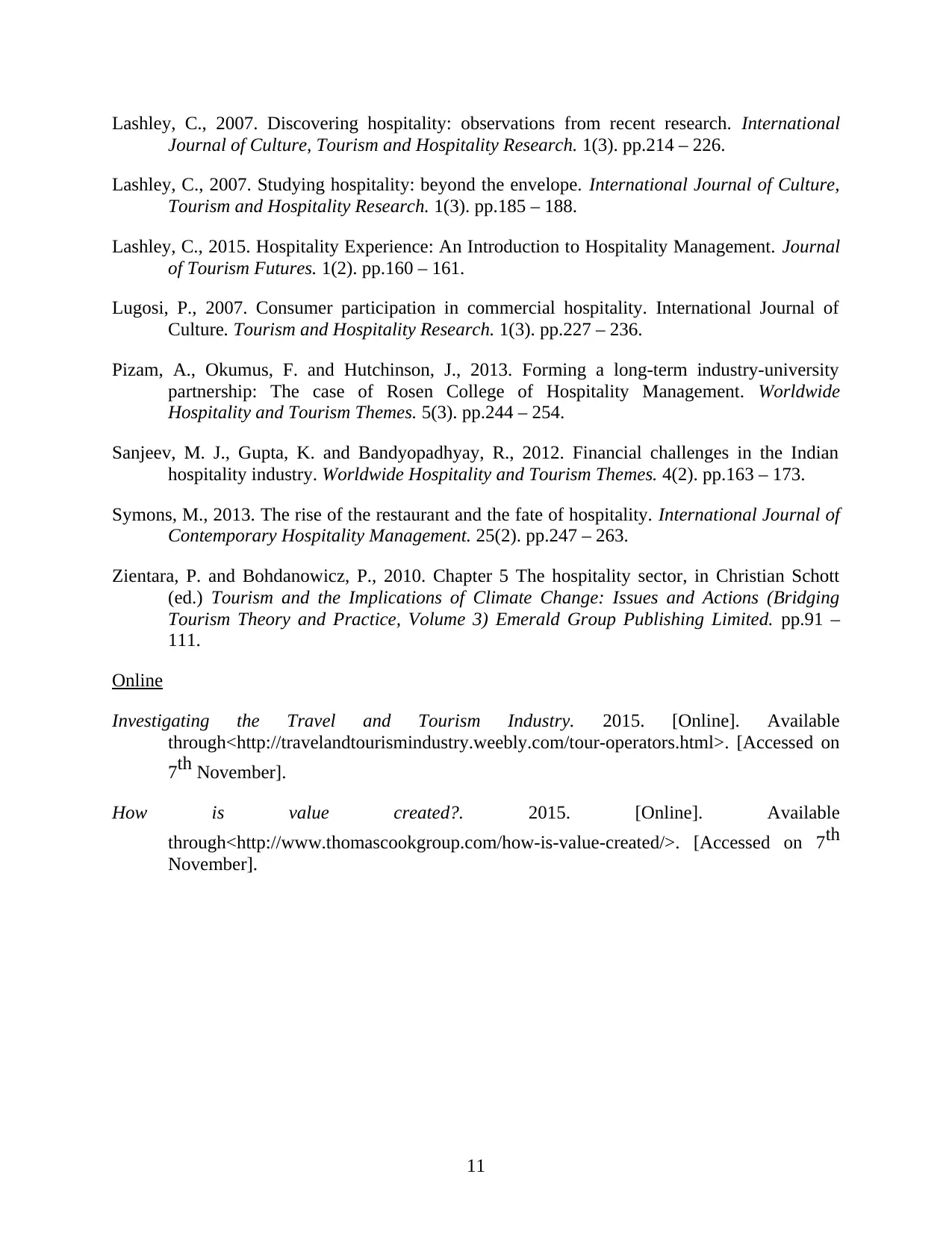
Lashley, C., 2007. Discovering hospitality: observations from recent research. International
Journal of Culture, Tourism and Hospitality Research. 1(3). pp.214 – 226.
Lashley, C., 2007. Studying hospitality: beyond the envelope. International Journal of Culture,
Tourism and Hospitality Research. 1(3). pp.185 – 188.
Lashley, C., 2015. Hospitality Experience: An Introduction to Hospitality Management. Journal
of Tourism Futures. 1(2). pp.160 – 161.
Lugosi, P., 2007. Consumer participation in commercial hospitality. International Journal of
Culture. Tourism and Hospitality Research. 1(3). pp.227 – 236.
Pizam, A., Okumus, F. and Hutchinson, J., 2013. Forming a long‐term industry‐university
partnership: The case of Rosen College of Hospitality Management. Worldwide
Hospitality and Tourism Themes. 5(3). pp.244 – 254.
Sanjeev, M. J., Gupta, K. and Bandyopadhyay, R., 2012. Financial challenges in the Indian
hospitality industry. Worldwide Hospitality and Tourism Themes. 4(2). pp.163 – 173.
Symons, M., 2013. The rise of the restaurant and the fate of hospitality. International Journal of
Contemporary Hospitality Management. 25(2). pp.247 – 263.
Zientara, P. and Bohdanowicz, P., 2010. Chapter 5 The hospitality sector, in Christian Schott
(ed.) Tourism and the Implications of Climate Change: Issues and Actions (Bridging
Tourism Theory and Practice, Volume 3) Emerald Group Publishing Limited. pp.91 –
111.
Online
Investigating the Travel and Tourism Industry. 2015. [Online]. Available
through<http://travelandtourismindustry.weebly.com/tour-operators.html>. [Accessed on
7th November].
How is value created?. 2015. [Online]. Available
through<http://www.thomascookgroup.com/how-is-value-created/>. [Accessed on 7th
November].
11
Journal of Culture, Tourism and Hospitality Research. 1(3). pp.214 – 226.
Lashley, C., 2007. Studying hospitality: beyond the envelope. International Journal of Culture,
Tourism and Hospitality Research. 1(3). pp.185 – 188.
Lashley, C., 2015. Hospitality Experience: An Introduction to Hospitality Management. Journal
of Tourism Futures. 1(2). pp.160 – 161.
Lugosi, P., 2007. Consumer participation in commercial hospitality. International Journal of
Culture. Tourism and Hospitality Research. 1(3). pp.227 – 236.
Pizam, A., Okumus, F. and Hutchinson, J., 2013. Forming a long‐term industry‐university
partnership: The case of Rosen College of Hospitality Management. Worldwide
Hospitality and Tourism Themes. 5(3). pp.244 – 254.
Sanjeev, M. J., Gupta, K. and Bandyopadhyay, R., 2012. Financial challenges in the Indian
hospitality industry. Worldwide Hospitality and Tourism Themes. 4(2). pp.163 – 173.
Symons, M., 2013. The rise of the restaurant and the fate of hospitality. International Journal of
Contemporary Hospitality Management. 25(2). pp.247 – 263.
Zientara, P. and Bohdanowicz, P., 2010. Chapter 5 The hospitality sector, in Christian Schott
(ed.) Tourism and the Implications of Climate Change: Issues and Actions (Bridging
Tourism Theory and Practice, Volume 3) Emerald Group Publishing Limited. pp.91 –
111.
Online
Investigating the Travel and Tourism Industry. 2015. [Online]. Available
through<http://travelandtourismindustry.weebly.com/tour-operators.html>. [Accessed on
7th November].
How is value created?. 2015. [Online]. Available
through<http://www.thomascookgroup.com/how-is-value-created/>. [Accessed on 7th
November].
11
1 out of 13
Related Documents
Your All-in-One AI-Powered Toolkit for Academic Success.
+13062052269
info@desklib.com
Available 24*7 on WhatsApp / Email
![[object Object]](/_next/static/media/star-bottom.7253800d.svg)
Unlock your academic potential
© 2024 | Zucol Services PVT LTD | All rights reserved.





